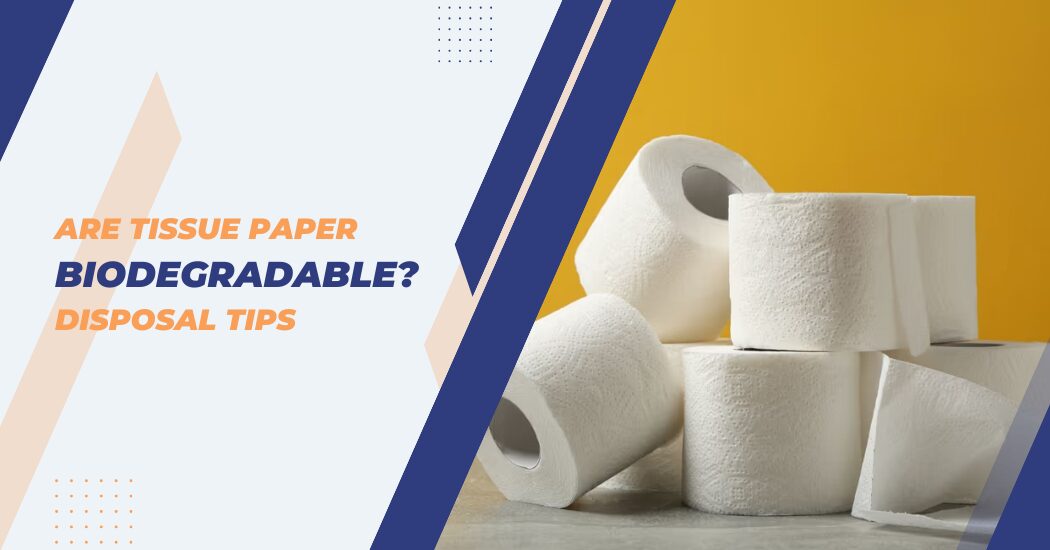Are tissue paper biodegradable?
Environmental impact of everyday products has become a growing concern in recent years, prompting individuals and industries to evaluate the biodegradability of commonly used items. Tissue paper, a ubiquitous commodity in households and businesses, raises questions about its ecological footprint.
Understanding whether is tissue paper biodegradable becomes crucial as sustainability gains traction in consumer consciousness.
In this exploration, we delve into the composition of tissue paper, its degradation processes and the broader implications for environmental sustainability. Unraveling the biodegradability of tissue paper is a fundamental step in making informed choices that align with eco-friendly practices.
Biodegradability of Tissue Paper
Tissue paper is a lightweight, soft, and thin product primarily used for hygiene and cleaning. It is made from cellulose fibers derived from wood pulp or recycled paper products. These fibers are structured to allow tissue paper to be easily torn into small pieces.
Biodegradability of tissue paper depends on several factors. In general, tissue paper is considered biodegradable as it can be broken down into smaller pieces by natural processes.
One of the main components of tissue paper, cellulose fibers, is highly susceptible to biodegradation. These fibers are easily digested by microorganisms present in the environment, such as bacteria and fungi. As a result, tissue paper can be decomposed into simpler organic compounds over time.
Factors influencing biodegradability of tissue paper
- Type of fibers used: Different types of fibers used in tissue paper production have varying levels of biodegradability. For example, softwood fibers, commonly used in tissue paper, are more easily digested by microorganisms compared to hardwood fibers.
- Bleaching process: Tissue paper can also go through a bleaching process to achieve its white color. The chemicals used in this process can affect the biodegradability of the paper.
- Ink and dyes: Tissue paper may also contain ink and dyes, which can impact its biodegradability. Natural or plant-based inks and dyes are more environmentally friendly compared to synthetic ones.
- Recycled content: Tissue paper made from recycled materials may have a lower environmental impact as it reduces the need for new resources. However, the quality and composition of the recycled fibers can also affect their biodegradability.
- Moisture and oxygen availability: The presence of moisture and oxygen is crucial for the breakdown of tissue paper. In dry and anaerobic environments, tissue paper may take longer to degrade.
- pH levels: pH levels of the environment can also impact the biodegradation process. If tissue paper ends up in an acidic or alkaline environment, it may not break down as quickly.
- Temperature: Higher temperatures generally promote faster biodegradation, while lower temperatures can slow down the process. This is why tissue paper may degrade more quickly in warmer, tropical climates compared to colder regions.
By understanding the factors that affect the biodegradability of tissue paper, we can make more informed choices about the products we use and how we dispose of them.
Steps to bio-degrade tissue paper
To properly biodegrade tissue paper, follow these steps:
- Separate any contaminated or non-biodegradable materials from the tissue paper.
- Shred or tear the tissue paper into smaller pieces to increase its surface area and allow for faster decomposition.
- Create a compost pile or add the shredded tissue paper to an existing compost bin. Make sure to mix it with other organic materials such as food scraps, leaves and yard waste.
- Keep the compost pile moist but not too wet and regularly turn it to provide oxygen for the microorganisms responsible for decomposition.
- Monitor the compost pile’s temperature, as tissue paper will break down faster at higher temperatures.
- Once fully decomposed, use the resulting nutrient-rich compost in your garden or for other purposes.
By following these steps, you can effectively biodegrade tissue paper and contribute to a more sustainable waste management system. So, it is important to choose biodegradable tissue paper and dispose of it properly to reduce our environmental impact.
Impact of biodegradable tissue paper on environment
Here are some ways in which using biodegradable tissue paper can benefit the environment:
- Reduced waste in landfills: Biodegradable Tissue paper can help reduce the amount of waste sent to landfills. This, in turn, helps mitigate the negative environmental effects of overflowing landfills.
- Less pollution: Biodegradable tissue paper also reduces pollution during its decomposition process. Synthetic materials used in non-biodegradable tissue paper can release harmful chemicals into the environment as they break down.
- Conservation of resources: By using biodegradable tissue paper, we can conserve natural resources such as trees and water, which are used in their production. This promotes sustainability and helps reduce our environmental impact.
- Minimizes carbon footprint: Production of tissue paper from virgin materials requires a significant amount of energy and emits carbon dioxide. By using biodegradable tissue paper, we can reduce our carbon footprint and contribute to fighting climate change.
- Protection of wildlife: Non-biodegradable tissue paper that ends up in the environment can cause harm to wildlife. Animals may ingest or become entangled in it, leading to injury or death. Biodegradable tissue paper reduces this risk and helps protect wildlife.
- Contributes to a circular economy: Biodegradable tissue paper can be recycled and reused, promoting a circular economy where materials are used in a loop without creating waste. This reduces our reliance on single-use products and helps create a more sustainable future.
By choosing biodegradable tissue paper, we can make a positive impact on the environment and promote a more sustainable way of living. It is essential to consider not only the convenience but also the environmental impact of the products we use in our daily lives.
Comparison with other types of paper products
While tissue paper is commonly used for personal hygiene and cleaning purposes, other types of paper products also have their environmental implications.
- Toilet paper: Like tissue paper, toilet paper is also designed to be flushed down the toilet and can therefore clog pipes and contribute to sewage blockages. However, biodegradable toilet paper made from recycled materials can help reduce this issue.
- Paper towels: Paper towels are commonly used for cleaning and drying surfaces but they are often non-biodegradable and contribute to landfill waste. Biodegradable paper towels made from recycled materials or plant-based fibers can be a more environmentally friendly option.
- Napkins: Napkins, like tissue paper, are designed to be disposable and can contribute to waste in landfills. Biodegradable napkins made from recycled materials or bamboo, which is a fast-growing and renewable resource, can help reduce their environmental impact.
- Wrapping paper: Wrapping paper is commonly used for gift-giving but often contains non-biodegradable materials such as glitter and plastic coatings. Choosing biodegradable options made from recycled materials can help reduce waste.
When it comes to choosing paper products, opting for biodegradable and sustainable options can have a positive impact on the environment. Therefore, considering the type of paper product we use and its environmental impact is crucial in promoting a more sustainable lifestyle.
FAQs
How long does it take for a paper tissue to decompose?
It can take anywhere from 2 weeks to 6 months for tissue paper to fully decompose, depending on the environmental conditions and the size of the tissue.
Are all tissue papers environmentally friendly?
No, not all tissue papers are environmentally friendly. Tissue paper made from virgin materials or containing synthetic additives is not biodegradable and can hurt the environment.
Can tissue paper be recycled?
Yes, some types of tissue paper can be recycled. However, it is important to check with your local recycling facilities as they may have specific guidelines for what types of tissue paper they can accept.
It is also important to ensure the tissue paper is clean and free of contaminants before recycling. Overall, using biodegradable tissue paper and properly disposing of it through composting can be a more environmentally friendly option.
Conclusion
Tissue paper is designed to be biodegradable, as it primarily consists of natural fibers. However, the presence of certain chemicals or non-biodegradable elements in some types of tissue paper may hinder its eco-friendliness.
Consumers play a crucial role in promoting sustainability by choosing tissue products labeled as “biodegradable” or “eco-friendly” and ensuring proper disposal methods, such as composting or recycling.
As environmental awareness grows, manufacturers are increasingly adopting sustainable practices to produce tissue paper that aligns with eco-conscious principles. By making small but impactful changes in our daily lives, such as switching to biodegradable tissue paper, we can all contribute to a healthier and more sustainable planet.






